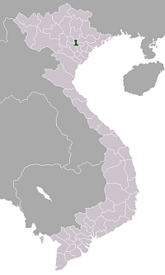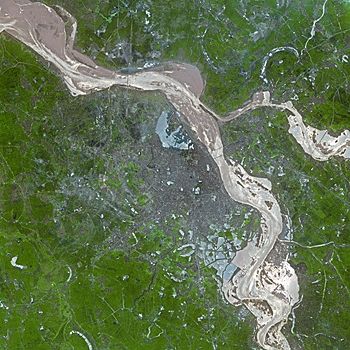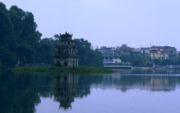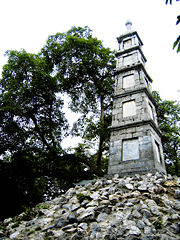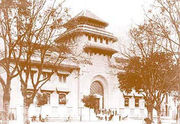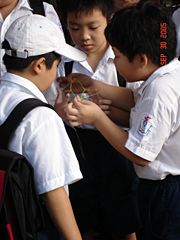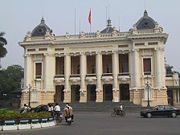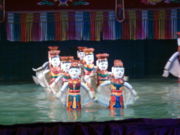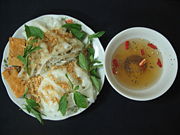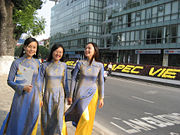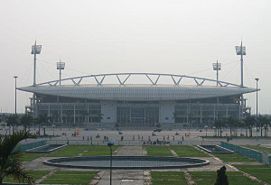Hanoi
2008/9 Schools Wikipedia Selection. Related subjects: Geography of Asia
| The City of Hanoi Hà Nội (River Interior) |
|||
 |
|||
|
|||
| Central city | Hanoi | ||
|---|---|---|---|
| Districts | 14 | ||
| Founded, Capital of the Đại Việt Kingdom | 1010 | ||
| Capital of Vietnam | September 2, 1945 | ||
| Area | |||
| - City | 920.97 km² (355.6 sq mi) | ||
| - Urban | 186.22 km² (71.9 sq mi) | ||
| Population (2007) | |||
| - City | 3.398.889 | ||
| - Density | 3,347/km² (8,668.7/sq mi) | ||
| Website: www.hanoi.gov.vn | |||
Hanoi ( Vietnamese: Hà Nội, Hán Tự: 河 内) pronunciation , estimated population 3.398.889 (2007) , is the capital of Vietnam. From 1010 until 1802, it was the political centre of an independent Vietnam with a few brief interruptions. It was eclipsed by Huế during the Nguyen Dynasty as the capital of Vietnam, but served as the capital of French Indochina from 1887 to 1954. From 1954 to 1976, it was the capital of North Vietnam.
The city is located on the right bank of the Red River. Hanoi is located at 21°2' North, 105°51' East, 1760 km (1094 mi) north of Ho Chi Minh City.
On May 29 2008, it is decided that Ha Tay province, Vinh Phuc's Me Linh district and 3 communes of Luong Son district, Hoa Binh will be merged into the metropolitan area of Hanoi from August 1 2008. Hanoi's total areas will be maximized 3 times to 334,470 hectares divided into 29 subdivisions. The new population is 6,232,940.
History
The area around modern Hanoi has been inhabited since at least 3000 BC. One of the first known permanent settlements is the Co Loa citadel founded around 200 BC.
Hanoi has had many names throughout history, all of them of Sino-Vietnamese origin. During the Chinese domination of Vietnam, it was known as Tống Bình (宋平) and later Long Đỗ. In 866, it was turned into a citadel and was named Đại La (大羅).
In 1010, Lý Thái Tổ, the first ruler of the Lý Dynasty, moved the capital of Đại Việt (大越, the Great Viet, then the name of Vietnam) to the site of the Đại La Citadel. Claiming to have seen a dragon ascending the Red River, he renamed it Thăng Long (昇龍, Ascending dragon) - a name still used poetically to this day. It remained the capital of Vietnam until 1397, when the capital was moved to Thanh Hóa, also known as Tây Đô (西都, Western Capital). Thăng Long then became Đông Đô (東都, Eastern Capital).
In 1408, Vietnam was invaded by Chinese troops from the Ming Dynasty and Đông Đô was renamed Đông Quan (東關, Eastern Gateway) by the Chinese. In 1428, Vietnam was liberated from Chinese rule by Lê Lợi, the founder of the Le Dynasty and Đông Quan was renamed Đông Kinh (東京, Eastern Capital - the name known to Europeans as Tonkin; and evidently, the same characters used for Tokyo). During the Tây Sơn Dynasty, it was named Bắc Thành (北城, Northern Citadel).
In 1802, when the Nguyễn Dynasty was established and then moved the capital down to present-day Huế, it was renamed Thăng Long ( "ascending dragon"). However, the second syllable of the toponym is actually a homonym of the word long, and so, actually suggests “to flourish” as opposed to “dragon”. Therefore, the name would then have appeared as 昇隆, roughly to ascend and flourish. In 1831 the Nguyen Dynasty renamed it Hà Nội ( 河 内, can be translated as Between Rivers or River Interior) . Hanoi was occupied by the French in 1873 and passed to them ten years later. It became the capital of French Indochina after 1887.
The city was occupied by the Japanese in 1940, and liberated in 1945, when it became the seat of Vietnam's government. From 1946 to 1954, it was the scene of heavy fighting between the French and Viet Minh forces. At that point, the city became the capital of an independent North Vietnam.
During the Vietnam War Hanoi's transportation facilities were disrupted by the bombing of bridges and railways, which were, however, promptly repaired. Following the end of the war, Hanoi became the capital of Vietnam when North and South Vietnam were reunited on July 2, 1976.
Geography
Hanoi experiences the typical climate of northern Vietnam, where summers are hot and humid, and winters are relatively cool and dry. The summer months from May to September receive the majority of rainfall in the year (1,682 mm rainfall/ year). The winter months from November to March are relatively dry, although spring then often brings light rains. The minimum winter temperature in Hanoi can dip as low as 6–7°C (43°F) not including the wind chill, while summer can get as hot as 38–40°C (100-104°F).
| Weather averages for Hanoi | |||||||||||||
|---|---|---|---|---|---|---|---|---|---|---|---|---|---|
| Month | Jan | Feb | Mar | Apr | May | Jun | Jul | Aug | Sep | Oct | Nov | Dec | |
| Average high °C (°F) | 19 (66) | 19 (67) | 22 (72) | 27 (80) | 31 (87) | 32 (90) | 32 (90) | 32 (89) | 31 (88) | 28 (82) | 24 (76) | 22 (71) | |
| Average low °C (°F) | 14 (58) | 16 (60) | 18 (65) | 22 (71) | 25 (77) | 27 (80) | 27 (80) | 27 (80) | 26 (78) | 23 (73) | 19 (66) | 16 (60) | |
| Precipitation mm (inches) | 20.1 (0.79) | 30.5 (1.20) | 40.6 (1.60) | 80 (3.15) | 195.6 (7.70) | 240 (9.45) | 320 (12.6) | 340.4 (13.4) | 254 (10.0) | 100.3 (3.95) | 40.6 (1.60) | 20.3 (0.80) | |
| Source: weather.comand asiaforvisitors.com 2008-02-26 | |||||||||||||
Education
Hanoi, as the capital of French Indochina, was home to the first Western-style universities in Indochina, including: Indochina Medical College (1902) - now Hanoi Medical University, Indochina University (1904) - now Hanoi National University, and École Supérieure des Beaux-Arts de L'Indochine (1925) - now Hanoi University of Fine Art.
After the Communist Party took control over Hanoi in 1954 with support from the Soviet Union, many new universities were built, such as Hanoi University of Technology, Le Quy Don Technical University, University of Foreign Trade (Vietnam), and Water Resources University (Vietnam). Hanoi University of Technology remains the largest technical university in Vietnam.
Hanoi is the largest centre of education in Vietnam. It is estimated that 62 % of the scientists in the whole country are living and working in Hanoi. Admissions to undergraduate study are through entrance examinations, which are conducted annually and open for everyone (who has successfully completed his/her secondary education) in the country. The majority of universities in Hanoi are public, although in recent years a number of private universities have started their operation. Thang Long university, founded in 1988, by some Vietnamese mathematics professors in Hanoi and France is the first private university in Vietnam.
Because many of Vietnam's major universities are located in Hanoi, students from other provinces (especially in the northern part of the country) wishing to enter university often travel to Hanoi for the annual entrance examination. Such events often take place in June and July, during which a large number of students and their families converge on the city for several weeks around this intense examination period. In recent years, these entrance exams have been centrally coordinated by the Ministry of Education, but passing marks are decided independently by each university.
Pre-tertiary (elementary and secondary) schools in Hanoi mainly serve their local districts. Education is equivalent to the K–12 system in the US, with elementary school between grades 1 and 5, middle school (or junior high) between grades 6 and 9, and high school from grades 10 to 12.
Tourist Attractions
As the capital of Vietnam for almost a thousand years, Hanoi is considered to be the cultural centre of Vietnam, where every dynasty has left behind their imprint. Even though some relics have not survived through wars and time, the city still has many interesting cultural and historic monuments for visitors and residents alike. Historians liken the life-giving Red River with its banks crowded with green rice paddies and farms to the Tigris and Euphrates rivers; a cradle of civilization. Even when the nation's capital moved to Hue under the Nguyen dynasty in 1802, the city of Hanoi continued to flourish, especially after the French took control in 1888 and modeled the city's architecture to their tastes, lending an important aesthetic to the city's rich stylistic heritage. The city boasts more than 1,000 years of history, and that of the past few hundred years has been well preserved.
Hanoi hosts more cultural sites than any city in Vietnam, including over 600 pagodas and temples.
The Old Quarter, near Hoan Kiem lake, has the original street layout and architecture of old Hanoi. At the beginning of the 20th century the city consisted of only about 36 streets, most of which are now part of the old quarter. Each street then had merchants and households specialized in a particular trade, such as silk traders, jewellery, etc. The street names nowadays still reflect these specializations, although few of them remain exclusively in their original commerce. The area is famous for its small artisans and merchants, including many silk shops. Local cuisine specialties as well as several clubs and bars can be found here also. A night market (near Đồng Xuân market) in the heart of the district opens for business every Friday, Saturday, and Sunday evening with a variety of clothing, souvenirs and food.
Some others prominent places are: The Temple of Literature (Văn Miếu), site of the oldest university in Vietnam 1070; One Pillar Pagoda (Chùa Một Cột); Flag Tower of Hanoi (Cột cờ Hà Nội). In 2004, a massive part of the 900 year old citadel was discovered in central Hanoi, near the site of Ba Dinh square.
A city between the rivers, built from lowland, Hanoi has many scenic lakes and sometime is called "city of lakes". Among its lakes, the most famous are Hoan Kiem Lake, West Lake, Halais Lake (Hồ Thiền Quang) in Vietnamese), and Bay Mau Lake. West Lake (Hồ Tây) is a popular place for people to spend time. It is the largest lake in Hanoi and there are many temples in the area. There are small boats for hire and a floating restaurant.
Under French rule, as an administrative centre for the French colony of Indochina, the French colonial architecture style became donminant, many examples remain today: the tree-lined boulevards (e.g Phan Dinh Phung street), The Grand Opera House, The State Bank of Vietnam (formerly The Bank of Indochina), The Presidential Palace (formerly Place of The Governor-General of French Indochina), the cathédrale St-Joseph, and historic hotel Sofitel Metropole.
Museums
Hanoi is also home to a number of museums:
- National Museum of Vietnamese History
- Vietnam National Museum of Fine Arts
- Vietnam Museum of Ethnology
- Vietnam Museum of Revolution
- Hanoi Hilton
- Ho Chi Minh Museum
- Contemporary Arts Centre
Hotels
There are some luxury hotels located in Hanoi, including: Sofitel Metropole and Hilton Hanoi Opera.
Sofitel Metropole is a historic hotel remaining from the French colonialism in Hanoi. The hotel was rewarded the second nicest hotel in Asia by Condé Nast Traveler Magazine thanks to its antiquated beauty (2007)..
Entertainment
A variety of options for entertainment in Hanoi can be found throughout the city. Modern and traditional theaters, cinemas, karaoke bars, dance clubs, bowling alleys, and an abundance of opportunities for shopping provide leisure activity for both locals and tourists. With its rapid growth and extremely high population density, several modern shopping centers have been built in Hanoi. Metro Hanoi, Vincom City Towers, Big C Thang Long Supercenter, Me Linh Plaza Furniture Hypermarket, Pico Plaza Electronics Hypermarket, and Trang Tien Plaza have all established large crowds on a regular basis. Multiple supermarket chains have also proved successful in Hanoi, including Intimex, HaproMart, Fivimart and Marko.
Hanoi is home to no fewer than ten movie theaters, with more in development, most of which feature films in both Vietnamese and English with appropriate subtitles. Currently, Megastar Cineplex provides the only screens in town equipped with Dolby Digital sound.
Cuisine
Hanoi has rich food traditions and many of Vietnam's most famous dishes, such as phở, chả cá, bánh cuốn and cốm are thought to come from Hanoi. Perhaps most widely known is Phở, a simple rice noodle soup often eaten as a breakfast dish in the home or at streetside cafes, but also served in restaurants as a meal. Two varieties dominate the Hanoi scene: Phở Bò, containing beef, and Phở Gà, containing chicken.
Population
Hanoi's population is constantly growing (about 3,5% per year ), a reflection of the fact that the city is both a major metropolitan area of Northern Vietnam, and also the country's political centre. This population growth also puts a lot of pressure onto the infrastructure, some of which is antiquated and dates back from the early 20th century.
The number of Hanoians who settled down for more than three generations is likely to be very small as compared to the overall population of the city. Even in the Old Quarter, where commerce started hundreds years ago and was mostly a family business, many of the street-front stores nowadays are owned by merchants and retailers from other provinces. The original owner family may have either rented out the store and moved to live further inside the house, or just moved out of the neighbourhood altogether. The pace of change has especially escalated after the abandonment of central-planing economic policies, and relaxing of the district-based household registrar system.
Transportation
Hanoi is served by Noi Bai International Airport, located in the Soc Son District, approximately 40 km (25 miles) north of Hanoi. Noi Bai is the only international airport for the northern regions of Vietnam. Direct daily flights are available to other cities in Vietnam, Asia, Australia, and Europe. The airport has recently been rebuilt with modern facilities.
There are two main highways linking the airport and city. The route to the city via Thang Long Bridge is more direct than Highway 1, which runs along the outskirts of the city. The main highways are shared by cars, motor scooters, with separate lanes by the side for bicycles. Taxis are plentiful and usually have trip meters, although it is also common to agree on the trip price before taking a taxi from airport to the city centre. Tourists also sometimes tour the city on cyclos especially in the Old Quarter.
Hanoi is also the origin departure point for many train routes in the country. The Union Express (tàu Thống Nhất) runs from Hanoi to Ho Chi Minh City from Hanoi station (formerly Hang Co station), with stops at cities and provinces along the line. Trains also depart Hanoi frequently for Hai Phong and other northern cities.
The main means of transport within the city are motorbikes, buses, taxis, and bicycles. Motorbikes remain the most common way to move around the city. Public buses run on many routes and fare can be purchased on the bus. For short trips, "xe ôm" (literally, "hug vehicle") motorcycle taxis are available where the passenger sits at the rear of a motorbike.
Economy
Hanoi has the highest Human Development Index among the cities in Vietnam. Though representing only 3.6 percent of the country's population and 0.3 percent of the national territory, Hanoi contributes 15 percent to the national GDP and 45 percent of the Red River Delta's economy.
Industrial production in the city has experienced a rapid boom since the 1990s, with average annual growth of 19.1 percent from 1991–95, 15.9 percent from 1996–2000, and 20.9 percent during 2001–2003. In addition to eight existing industrial parks, Hanoi is building five new large-scale industrial parks and 16 small- and medium-sized industrial clusters. The non-state economic sector is expanding fast, with more than 48,000 businesses currently operating under the Enterprise Law (as of 3/2007) .
Trade is another strong sector of the city. In 2003, Hanoi had 2,000 businesses engaged in foreign trade, having established ties with 161 countries and territories. The city's export value grew by an average 11.6 percent each year from 1996–2000 and 9.1 percent during 2001–2003. The economic structure also underwent important shifts, with tourism, finance, and banking now playing an increasingly important role.
Hanoi's business districts are traditionally Hoan Kiem and the neighbourhood; and a newly developing Trung Hoa Nhan Chinh in the South Western.
Similar to Ho Chi Minh City, Hanoi enjoys a rapidly-developing real estate market. The metropolis's economy growth does not seem correlative to its infrastructure. Overloading population requires a much larger supply of accommodations, while the constructing celerities of both transport system and new urban areas are too low. Not surprisingly, as an effect of this problem, the apartment and real estate fever occur severely during the time. More widespread, the fever even influences Ha Tay, the neighboring province, considered the future development space of the capital. The current most notable new urban areas are central Trung Hoa Nhan Chinh, My Dinh, the luxurious zones of The Manor and Ciputra.
Agriculture, previously a pillar in Hanoi's economy, has striven to reform itself, introducing new high-yield plant varieties and livestock, and applying modern farming techniques.
Together with economic growth, Hanoi's appearance has also changed significantly, especially in recent years. Infrastructure is constantly being upgraded, with new roads and an improved public transportation system. The rate of telephone users was 30 per 100 people in 2003. New urban areas are growing rapidly, with 1.5 million square metres of housing constructed during 1996–2000 and 1.3 million square metres built in 2003 alone.
Social services have been developed in both scale and quality. The public healthcare network has been strengthened, ensuring at least one doctor for each commune and ward. Thanks to these accomplishments, Hanoi has the highest development index in the country. Movements such as raising donations for poor people or promoting a "cultural lifestyle", have received support from local people and been maintained.
Sport Centers
There are several gymnasiums and stadiums throughout the city of Ha Noi. The biggest ones are My Dinh National Stadium ( Le Duc Tho Boulevard), Quan Ngua Sporting Palace ( Van Cao Avenue) and Underwater Sporting Palace. The others include Ha Noi stadium (as known as Hang Day stadium), Trinh Hoai Duc gymnasium, Gia Lam gymnasium, Cau Giay gymnasium, Hai Ba Trung gymnasium, Flag Pole stadium... It is decided that Asian Indoor Games will held at Hanoi in 2009.
Health care and other facilities
Some medical facilities in Hanoi:
- Bach Mai Hospital
- Viet Duc Hospital
- Saint Paul Hospital
- 108 Hospital
- L'Hôpital Français De Hanoï
- International SOS
Districts
Hà Nội is divided into five outer districts and nine inner districts.
The inner districts include:
- Ba Đình (Three Temples) - political centre, named after a destionation (there was a uprising) in Thanh Hoa.
- Cầu Giấy (Paper Bridge) - in the past, there were many traditional papermaking workshops.
- Đống Đa - named after a historic victory of Quang Trung again Qing Dynasty at this area.
- Hai Bà Trưng (Two First Ladies) - named after the two Vietnamese heroines Hai Ba Trung
- Hoàn Kiếm (Sword Recurrent)- downtown of Hanoi, named after the central lake - Hoan Kiem Lake
- Hoàng Mai (Yellow Ume) - where there were many ume/apricot trees.
- Long Biên (Dragon Fin) - across the Red River, named after the position as the traditional outskirt of Hanoi.
- Tây Hồ (West Lake) - named after the largest lake - West Lake (Hanoi).
- Thanh Xuân (literally Green Spring, i.e. Youth) - Industrial, labor district, a propaganda name from the past.
The outer districts include:
- Đông Anh
- Gia Lâm
- Sóc Sơn (Sóc Mountain)
- Thanh Trì (Green Ponds)- the lowest part of Hanoi, where there are many ponds.
- Từ Liêm
Sister cities
Photos of Hanoi
Literature
- Boudarel, Georges (2002). Hanoi: City Of The Rising Dragon. Rowman & Littlefield Publishers, Inc., 208 pages. ISBN 0-7425-1655-5.
- Logan, William S. (2001). Hanoi: Biography of a City. University of Washington Press, 304 pages. ISBN 0-295-98014-1.
